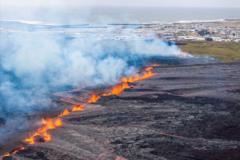The volcano in south-west Iceland erupted early Tuesday, prompting urgent evacuations of tourists and locals from the town of Grindavik and nearby sites, including the renowned Blue Lagoon spa. The eruption has been characterized by a dramatic display of orange-red lava and a fissure extending 1.2km (0.75 miles), which poses an immediate danger to the community. Amid a series of earthquakes preceding the eruption, local resident Asrun Kristinsdottir described the situation as alarming, noting her long-standing preparedness for such events but acknowledging a new level of worry due to the frequency of seismic activity.
Iceland's Meteorological Office (IMO) confirmed that protective barriers around Grindavik had been compromised, with new eruptions surfacing dangerously close to residential areas. Authorities urgently advised residents to vacate the danger zone, with reports indicating that a small number have opted to remain despite the risks. The town, home to about 4,000 residents, is facing the threat of lava encroaching on populated areas, prompting significant concern from local officials.
Reports indicate that utility issues, including a broken hot water pipe, signify the geological instability of Grindavik. Business owner Thormar Omarrson, who relocated his family last year due to safety concerns, lamented the emotional toll of leaving his lifelong home, as he expressed empathy towards those choosing to stay amidst the danger.
While magma activity has decreased in the early afternoon, the continuing threat remains significant. The latest series of eruptions has raised awareness of Iceland's volatile geological landscape, which is characterized by multiple active volcano systems. The potential for gas pollution from the eruption, directed northeast towards the capital, further complicates the emergency.
The Reykjanes Peninsula, which last experienced such frequent volcanic activity centuries ago, underscores the persistent geological challenges facing the region. As officials continue to monitor the situation, the priority remains the safety of residents and tourists in this beautiful yet unpredictable landscape.
Iceland's Meteorological Office (IMO) confirmed that protective barriers around Grindavik had been compromised, with new eruptions surfacing dangerously close to residential areas. Authorities urgently advised residents to vacate the danger zone, with reports indicating that a small number have opted to remain despite the risks. The town, home to about 4,000 residents, is facing the threat of lava encroaching on populated areas, prompting significant concern from local officials.
Reports indicate that utility issues, including a broken hot water pipe, signify the geological instability of Grindavik. Business owner Thormar Omarrson, who relocated his family last year due to safety concerns, lamented the emotional toll of leaving his lifelong home, as he expressed empathy towards those choosing to stay amidst the danger.
While magma activity has decreased in the early afternoon, the continuing threat remains significant. The latest series of eruptions has raised awareness of Iceland's volatile geological landscape, which is characterized by multiple active volcano systems. The potential for gas pollution from the eruption, directed northeast towards the capital, further complicates the emergency.
The Reykjanes Peninsula, which last experienced such frequent volcanic activity centuries ago, underscores the persistent geological challenges facing the region. As officials continue to monitor the situation, the priority remains the safety of residents and tourists in this beautiful yet unpredictable landscape.






















